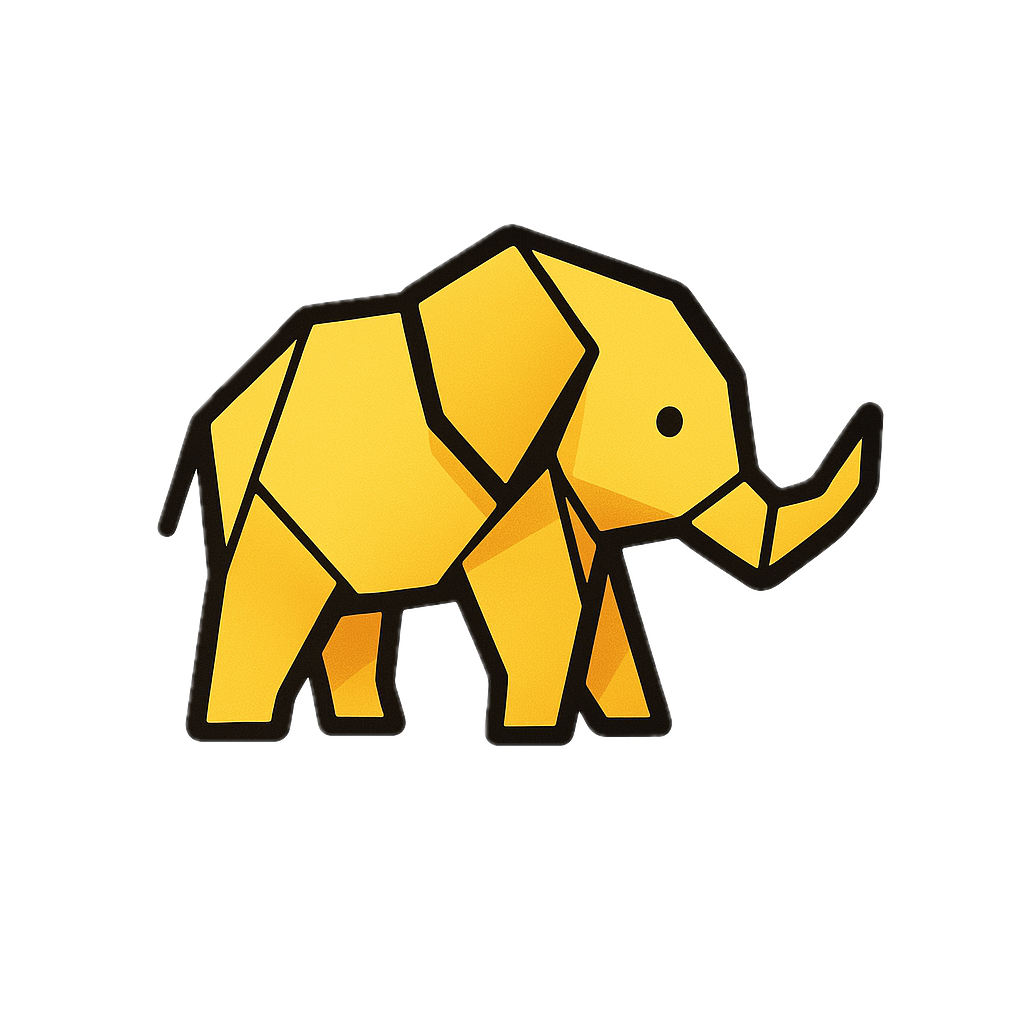Every topic that could come up in a GL 11 Plus Verbal Reasoning Exam
Verbal Reasoning is one of the four components of most GL 11 plus exams. This component seeks to test students’ ability to follow patterns and sequences using logic, as well as their spelling and vocabulary. Verbal Reasoning shouldn’t need excessive tutoring and instead the best way to prepare for this section of the exam is doing practice questions to become familiar with the different questions styles and to understand what they each are looking for.
GL uses 21 different types of verbal reasoning questions (shown below) although not all of them will be used in each exam. GL does not disclose which question types they will use before the exam takes place, so it is necessary to get practice and gain familiarity with each of the 21 types.
Type 1 - Crack The Letter Code
Type 1 is the first of four types of code questions.
In this type of question you will be given a word and its corresponding code. You will then be asked to find the code for a given word (or do the opposite: find the word for a given code) by applying the same pattern.
In order to work out the code, you are given the alphabet as a visual aid because the code will follow some sort of alphabetical pattern. For example the letters of the word might have been moved back 4 places in the alphabet.
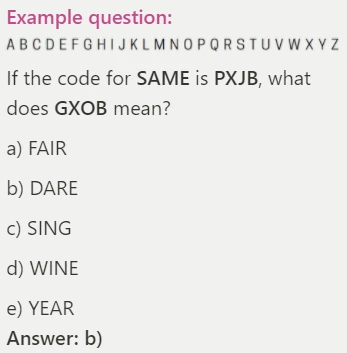
Type 2 - Complete the Letter Series
In the second type of code questions you will be presented with a series of two letter segments, and be asked to find the next two letters in the series.
This again follows an alphabetical pattern, so the key is to look for links between the sections of the code that you’ve already been given. In the example question we can see that the second letter of each section is L-M-N-O, so we can work out that the next letter will be P.
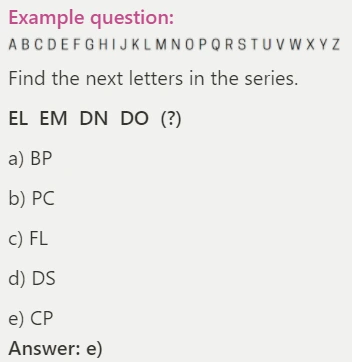
Type 3 - Complete the Letter Sentence
The third type of code questions asks you to complete a sentence by picking the two letters that will fit best. You work this out by inferring what the relationship is between the first two pairings of letters.
This is the last type of code questions that only uses letters, skip to ‘Type 19’ to see the final type of code questions.
Also, check out our 6 Tips to help your child master 11+ Verbal Reasoning Codes blog here.

Type 4 - Create a Compound Word
This one is fairly straight forward and requires a simple trial and error technique. Just add each of the words together from the first and second lists and see which words fit together to make another word.
It should be clear enough that ‘dogsilver’ isn’t a word whereas ‘without’ is.
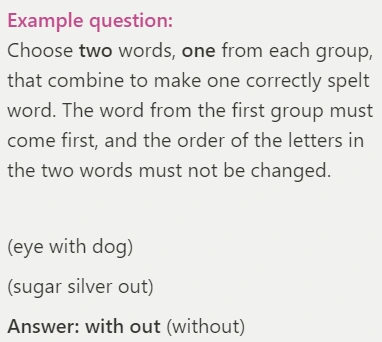
Type 5 - Find the Missing Letter
This question type asks you to find one letter that can go either at the beginning or end to all of the words provided. Again, working this one out might take the form of trial and error if the answer isn’t obvious at first glance, which sometimes it can be.
Some of the words given might be more obvious than others, so you should find those and work on them first. In the example question, there aren’t many letters that could go in front of ‘now’ (just s and k) to form a word, so you could focus first on finding a letter that would fit that, and then check if it fits into the other ones.
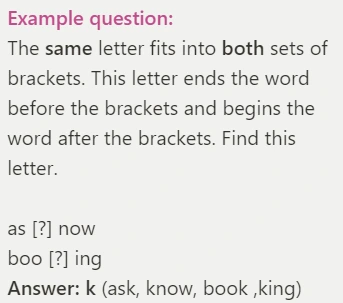
Type 6 - Move a Letter
In type 6 you have to remove one letter from the first word and place it in the second word in a way that ensures that both still form correctly-spelt words.
This tests students’ spelling, as well as their knowledge of vocabulary.
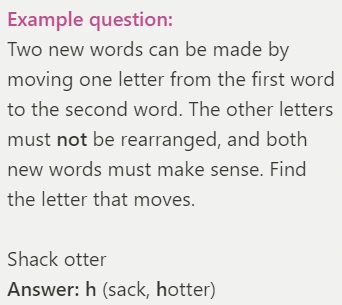
Type 7 - Find the Missing Three-Letter Word
In type 7 questions you have to find a three letter word that will fit into the word that is written with capital letters, in order to turn it into a longer word that will fit into the given sentence.
When doing this type of question, remember to make sure that the three letters you add can already make a word (such as ‘now’), and also check that they fit into the context of the sentence.
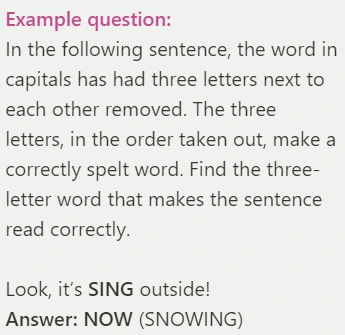
Type 8 - Create Words in the Same Way
For this type of question, you need to work out how the first three words go together, in order to find out the third word in the second group.
The pattern that links the three words will be different for each question, but it will always be based on the spellings of the words, rather than the meanings. In the example, we can see that the middle word takes ‘it’ from the first word and ‘s’ from the third to form ‘sit’.
Therefore we just need to apply that same logic to the second group of words – and combine the second two letters of the first word (at) with the first letter of the third word (b), to form bat.
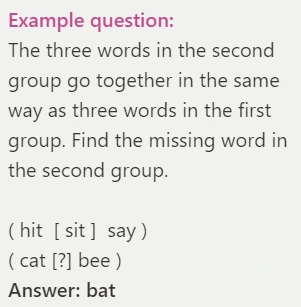
Type 9 - Solve Letter Sums
In type 9 we are presented with a sum, however the numbers have been replaced with letters. Using the key we have to work out the answer to the sum, and give the answer in letter form.
For students who struggle with this, the simplest thing is to write the numbers down above each letter and simply work out the sum.
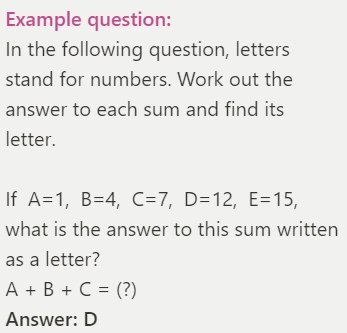
Type 10 - Continue the Number Series
Continuing with the numbers, here we are asked to find the next number in a given series. Therefore we just need to work out the link between each of the numbers we’re given, and apply that to find the answer.
In the example, each number is +3 from the previous one, therefore 14+3=17.

Type 11 - Find the Hidden Four-Letter Word
In type 11 questions we are given a sentence and asked to find a hidden four-letter word which is made from the end of one word in the sentence and the beginning of the following word.
The four-letter word does not necessarily need to be evenly split, so there may be 3 letters in one word and 1 in the other.

Type 12 - Find Words Closest in Meaning
While some of these types of question will be quite clear and straight-forward, others may be a bit tricky if there are lots of words with similar meanings or themes.
Therefore, make sure to check every possibility before picking your answer and moving on as you could find two words which are slightly closer in meaning than the ones you had initially chosen.

Type 13 - Related Words
Type 13 is similar to type 12 in that you have to focus on the meanings of similar words, and choose which ones are more related than others. Here, we are given 5 words and have to choose the two that do not fit with the other three.
In the example, while all 5 of the words are linked in some way, as most fruit have peels and seeds, only 3 of the words are names of fruit, so we can work out what the odd ones out are.
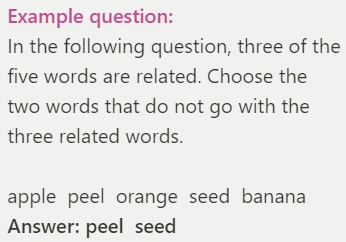
Type 14 - Find the Word Link
In type 14 we’re asked to complete a sentence by choosing the most appropriate words from two word banks.
This largely resembles type 12 and 13 in that we are given a selection of words that are all linked in meaning but we have to work out which ones fit best.

Type 15 - Explore the Facts & Solve the Riddle
Type 15 can be quite tricky as it requires us to read and process quite a lot of information, and to use that to work out a riddle.
These questions are written in such a way that we are given different pieces of information at a time and have to put them together to see the whole picture. Therefore a good idea might be to write things out in a more logical sense as we read them, such as by grouping together all of the information about each person or thing that is involved.
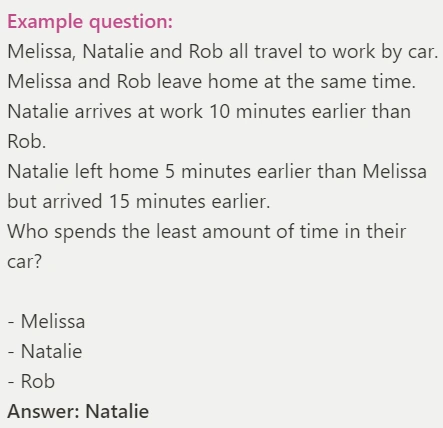
Type 16 - Find Words Opposite in Meaning
Type 16 takes us back to choosing words that are most appropriate due to their meaning, however this time we have to choose the words that are the most opposite in meaning.
This would therefore mean picking words that are linked but opposite – rather than words which have nothing to do with each other.
Examples would be words like ‘night’ and ‘day’, ‘up’ and ‘down’, ‘land’ and ‘sea’.
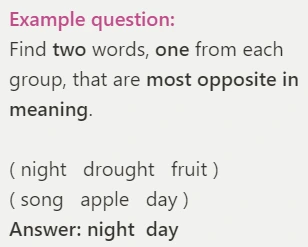
Type 17 - Find the Number to Complete the Sum
This type of question involves a bit of maths as well as inference based on what we’re given. We are asked to complete a sum (rather than find the answer to a calculation) by adding together the first half of the sum and working out how much has to be added to the third number given.
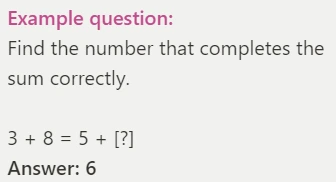
Type 18 - Find the Missing Number
Type 18 can seem confusing and a bit daunting at first. However once we work out the pattern of the first two groups it is simple enough.
In the example question, we see that the first two numbers in each group must be added together and then doubled to get the final number. Therefore the missing number in the last group is 2, as (2+6) x 2 = 16.
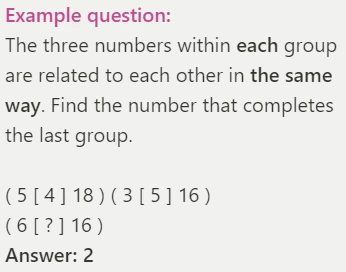
Type 19 - Crack the Number Code
As with the other types of code (question types 1-3) this type looks very complex at first glance, and therefore your child should get lots of practice of these.
In the fourth type of codes numbers are introduced. Here we have to work out the code for a word based on three other codes we’ve been given – however we first have to work out which of the first three codes applies to which of the other words we’ve been given.
One of the keys is to look for letters that the original 4 words have in common and finding common numbers in their related codes. In the example, we see that WISE and LINE both have I as the second letter and end in E, and 5687 and 1607 both have 6 as the second letter and end in 7, so I must be 6 and E must be 7 in the code. By making more inferences like this we can work out what WALK is in the code.

Type 20 - Complete the Third Pair in the Same Way
In this type of question we have to find the final word in a set based upon the words we’ve been given.
In the example we can see that the second word in each group is the same as the first word but with the second letter removed. However the pattern of the words will be different for each question.
As simple as it seems, it is always important to check that the word we create is a real English word, as otherwise it can’t be the correct answer.
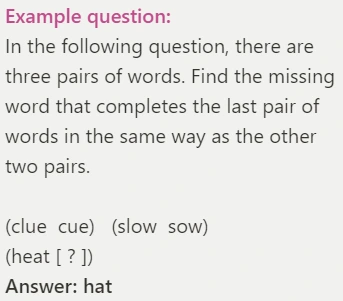
Type 21 - Find the Double Meaning
And finally, GL 11 plus Verbal Reasoning question type 21. Here, we are given four words which go together, and have to choose a fifth from a choice of five given words.
Again we have to really consider the specific meanings of each word as they all may have something in common, but only one fits exactly in with the first four words.
For example, while bath, puddle, ocean, tap and rain are all to do with water, only ocean fits with the first four words as it is a large natural body of water, which the other options are not.
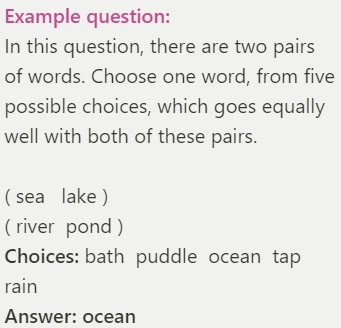
And there we have it, all of the 21 possible types of question that could come up in a GL Verbal Reasoning paper. Remember to check out all of the question types and topics from the other 11 plus subjects here.
As we said before, the best way to prepare for this type of exam is with regular, focused practice. Our Fundamentals Subscription is the perfect way to do this, and it covers all of the GL 11 Plus subjects and topics. Check it out here.
